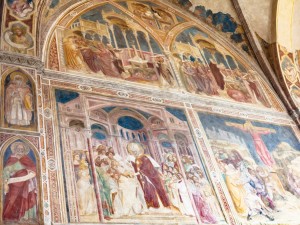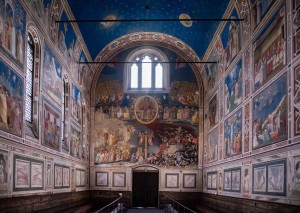
©Bigstock.com/vvoevale
Padua is widely regarded as one of the most beautiful cities in Italy, and with good reason. The oldest botanical garden in the world alone, a UNESCO World Heritage Site, has been attracting guests from all around the world for decades, and the historic centre with its churches, chapels and palaces is always worth a stroll. More than a stroll, come to think of it, as Padua was given a second World Heritage Site in 2021 leading you directly to the old city centre. The name “Padua’s fourteenth-century fresco cycles” stands for invaluable ceiling and wall frescoes across eight different buildings. Read on to find out which buildings and which artists we’re talking about, and what makes the fresco art of the so-called Trecento special.
Art revolution during the Trecento
The 14th century revolutionised Italian arts. Literature and music aside, the Proto-Renaissance era had a palpable effect on painters on sculptors, the so-called “Trecento” (short for “milletrecento”, the Italian word for “1300”) had begun. Siena, Pisa and Padua developed their own schools of art with techniques and innovations that quickly spread across the entire country and beyond. Two major developments soon dominated Italian studios: sinopia and giornata.
The so-called “pontata” dominated matters even into the 13th century. This approach focused on finishing pre-defined areas of plastering along a line of scaffolding regardless of the motif. However, the giornata aimed at completing full or partial motifs in a day’s work in order to achieve a more consistent look. Sinopia drawings were used to create this effect of structural uniformity. The masters usually took care of the big fresco picture by means of the drawing and their assistants received smaller areas for detail and precision work. This more precise composition of the painting design allows the Trecento artists to achieve more complex spatial depth and compositional structure. And that’s exactly what you get to look forward to inside Padua’s fresco buildings.
Padua’s most important fresco protagonists
Numerous artists played key roles in creating the World Heritage fresco cycles. Listing all of them would be a bit excessive, though, which is why we introduce you to three particularly important masters:
- Giotto: The trailblazer of the Italian Renaissance grew up the son of a blacksmith in Florence and, as such, has a close connection to the Tuscan city. However, he created his magnum opus in Padua. Giotto is regarded as the originator of Trecento fresco painting. His preparation of the perspective as well as the naturalness and liveliness of his characters revolutionised the art world moving away from the then prevalent two-dimensional presentation.
- Giusto de’ Menabuoi: Whether Giusto was a first-generation or second-generation student of Giotto remains unclear. Originally from Florence, too, he created countless invaluable frescoes during the second half of the 14th century working in Milan among other places. Spatial effects and a preference for a rich tapestry of bright colours characterise Giusto’s body of work.
- Guariento di Arpo: Unlike his prominent Trecento contemporaries Guariento di Arpo was actually born in Padua. His first big assignment was a cycle of angel depictions for the chapel of the Carrara residence. Guariento learned and applied his art in Padua with several World Heritage Site fresco cycles, but he also played a very important role as a propagator of Giotto’s innovations. His paradise painting in the Doge’s Palace advanced the end of an era of the mostly Byzantine art in Venice.
Eight buildings and their fresco cycles

©Bigstock.com/e.della
Now you’re familiar with the innovations during the Trecento and some of the artists responsible for the fresco cycles. Time for the main event – a look at the eight buildings that constitute the UNESCO World Heritage Site “Padua’s fourteenth-century fresco cycles”:
- Cappella degli Scrovegni: The former site of the ancient amphitheatre is now the first address for fresco art in Padua. Giotto painted the chapel during its construction from 1302 to 1306. The master’s influential magnus opus focuses on scenes depicting Mary’s parents, Mary herself and Jesus, and on depictions of the Last Judgement. The tunnel vault with its deep blue sky covered in golden stars watches over the breathtaking frescoes. Please note that you can only visit the chapel on advance registration for a maximum of 15 minutes.
- Chiesa degli Eremitani: Bomb raids during the Second World War severely damaged this church next to the Scrovegni Chapel before it was extensively renovated. Find the frescoes in the presbytery, where Guariento di Arpo and his students worked, and the Ovetari chapel. Here only two frescoes by Andrea Mantegna, Niccolò Pizzolo and two other painters are still well-preserved, the others were restored in pieces.
- Palazzo della Ragione: Padua’s former commercial centre with the court room on the upper floor unfortunately lost originals by Giotto and his students to a fire. Nicolò Miretto manged to restore them with slight modification from 1425 onward. The giant hall depicts month and planet allegories, signs of the zodiac, the corresponding saints, and characteristic professions and occupations.
- Loggia dei Carraresi: Only parts survived of the former stately residence of the Carrara family where Guariento di Arpo made his first fresco steps. This loggia with Old Testament scenes likely dates back to the mid-14th Sadly, opening this room led to damages and even the loss of some frescoes, but the biblical depictions still in existence are certainly more than worth seeing.
- Battistero del Duomo: There’s a Romanesque baptistery, finished in 1281 and painted with frescoes by Giusto de’ Menabuoi about one century later, next to the rather plain looking cathedral. This excellently preserved cycle is dedicated to the lives of Jesus and John the Baptist depicted on the walls and inside the cupola.
- Complesso della Basilica di Sant’Antonio di Padova: The Basilica of Saint Anthony is likely Padua’s most important, most glorious, and most versatile sight. Another deep-blue sky with golden stars and extensive embellishment leads your way through this monumental building. The side chapels are equipped with comprehensive fresco cycles. Look out for the chapel of Saint Jacob in the right transept. Altichiero da Zevio’s magnum opus features a crucifixion group and the story of Saint Jacob the Apostle among other things.
- Oratorio di San Giorgio: There’s another masterpiece by Altichiero da Zevio hidden near the basilica. The Oratorio di San Giorgio is also endowed with glorious frescoes focusing of the life of Jesus and various saints. Several martyrdom depictions impress with unrivalled poignancy. Another spectacular scene sees the noble knight George save a princess from a dragon.
- Oratorio di San Michele: Finally, we take a look at a fairly small, pretty much non-descript chapel built as some sort of makeshift structure in a destroyed church in 1397. Giacomo da Verona dedicated this fresco cycle to the life of the Virgin Mary with all the scenes you’d expect ranging from the Annunciation to the birth of Christ to her death. Looking closer at the extensive depictions that even extend into the insides of archways, you can discover a hidden Petrarca.
The legacy of the Trecento spread across all of Italy and most of Europe in no time. Padua’s fourteenth-century fresco cycles demonstrate the unique effect of its most important masterpieces in a more than impressive manner. All masters in one place, eight astonishing buildings and magical fresco cycles, and a plurality of fascinating depictions inside equally fascinating architecture – most certainly a set more than worth of being named “World Heritage”. By the way, there are even more – lots more! – frescoes waiting to be discovered in Padua. How about going on a city holiday soon?